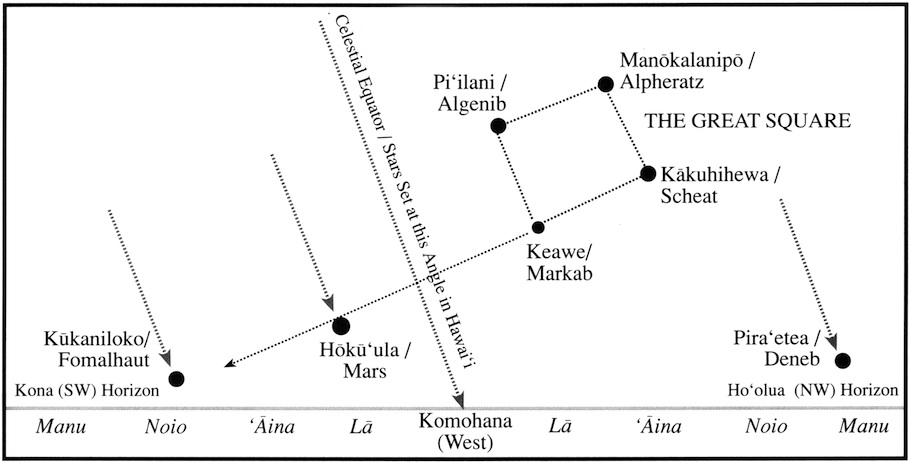Four Starlines Rising and Setting
1a. Ke Ka o Makali‘i Rising / 1b. Ke Ka o Makali‘i Setting
2a. Iwikuamo‘o Rising / 2b. Iwikuamo‘o Setting
3a. Manaiakalani Rising / 3b. Manaiakalani Setting
4a. Ka Lupe o Kawelo Rising / 4b. Ka Lupe o Kawelo Setting
Note: The night sky charts below that extend to the left and right margins of the text may be larger than they appear in this html file. You can view the larger charts by dragging the images from the browser onto your desktop, then opening them with graphic-viewing software. For print versions of the night-sky charts that would use less toner , you can use the Invert function in a graphic program like Photoshop (Image>Adjustments>Invert) to reverse the image (i.e., create a chart with a white sky and dark stars).
The charts depict the sky without regard to night or day. In daylight or under cloudy conditions at night you would not be able to see some or all of the sequence since the sky would be hidden by the light or clouds, although the stars would be moving in this sequence whether you can see them or not. In different months and seasons of the year, different portions of the sequence are visible at night. A navigator may time a voyage so that particular stars would be visible at night for navigation.
1a. Ke Ka o Makali‘i Rising
The chart below depicts Ke Ka o Makali‘i (The Bailer of Makali‘i) Rising. (See “Hawaiian Star Lines” for the names used in this and the other four star line. See “The Celestial Sphere” for an explanation of the rising and setting of stars.)
The chart below depicts the starline Ke Ka o Makali‘i rising in Honolulu, Hawai‘i, at 21 degrees N latitude. The horizontal line is the horizon, and the view is looking east, with north to the left and south to the right.
The brightest star in the sky, ‘A‘a (Sirius) provides an orientation point, above the horizon between E and SE. Just above the horizon between SE and S is Ke Al‘ii Kona i ka Lewa (Canopus) rising, marking SE by S point. Above ‘A‘a (Sirius) is Ka Hei-Hei o Na Keiki (Orion) with its distinctive row of three stars, framed by two pairs of stars on either side of it.

Due to the latitude of the observer in Honolulu, the stars appear to rise at a 21 degree angle from a perpendicular line intersecting the horizon at the point where the star rose from the horizon. You can judge the slope of this angle by imagining a line down from the highest star in the row of three stars in Ka Hei-Hei (Orion) down to the point marked E (east) on the horizon line, where this star, Mintaka, rose earlier. It has angled off to appear above south of E. (See “The Celestial Sphere” for an explanation of the angle of rising and setting of stars.)
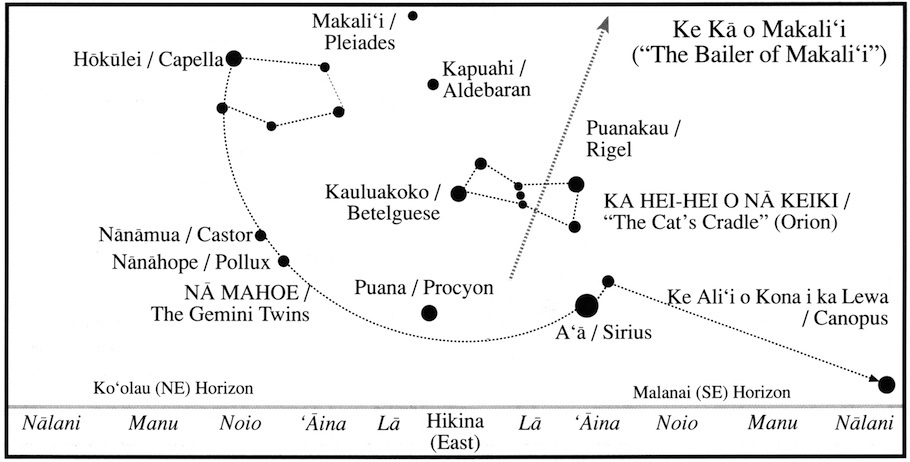
The angle of rising in Honolulu
To the left of ‘A‘a (Sirius), at about the same altitude, is Puana (Procyon), above E but having risen earlier E by N. To the left of Puana are a pair of stars, Na Mahoe, the Twins (Nanamua or Castor and Nanahope or Pollux). Above Na Mahoe is a circle or pentagram of stars called Hokulei, “Star-Wreath” (Auriga), with the brightest star at the top-left corner, also called Hokulei (Capella).
The five bright stars – ‘A‘a (Sirius), Puana (Procyon), Nanamua (Castor) and Nanahope (Pollux), and Hokulei (Capella) form Ke Ka o Makali‘i, the bailer cup or bowl of Makali‘i, from which this starline is named. It holds within it and seems to be lifiting from the ocean the following constellation and stars: Ka Hei-Hei (Orion); above Orion and straight up from Puana, Kapuahi (Aldebaran); and above Aldebaran, to the left, the small, relatively faint but distinct cluster of stars known Makali‘i (Pleiades). (For an explanation of how these stars and others are used in navigation, see Holding a Course.)
The next star line, Iwikuamo‘o, most of it below the horizon, includes the stationary Hokupa‘a, the North Star, at the NCP, marked by the small white cross (+) above north (the NCP is actually directly above North, but appears slightly to the right because of spatial distortion toward the side and top of the chart, which depicts a sphere on a flat two-dimensional surface); Na Hiku (Big Dipper) starting to rise at NNE, the two front stars of the cup of the dipper above the horizon, the other five stars still below it. The two front stars of the cup point upward to the left at Hokupa‘a (North Star) at the NCP.
The brightest star in the sky, below Na Hiku and the horizon between N and NE, is Hokule‘a (Arcturus). On the right side of the chart, the long luminous star-cloud that starts around SE and extends downward is Ka I‘a (the Fish), known in the West as the Milky Way. Embedded in Ka I‘a, below SE is Hanaiakamalama (Southern Cross, on its side,) and below it two bright stars pointing up at it, are Na Kuhikuhi, the Pointers, Kamailemua (Beta Centauri) and the brighter Kamailehope (Alpha Centauri).
1b. Ke Ka o Makali‘i Setting
With the observer looking W about seven and a half hours after the sky configuration depicted in the night sky chart 1a, Ke Ka o Makali‘i has cross the Meridian overhead and is setting in the West. The star near the horizon between S and SW is Ke Al‘ii Kona i ka Lewa (Canopus) setting SW by S. Ke Ka o Makali‘i, the curve formed by the bright stars of ‘A‘a (Sirius), Puana (Procyon), Nanamua (Castor) and Nanahope (Pollux), and Hokulei (Capella), is now an upside down bowl that seems to be pouring Ka Hei-Hei (Orion), Kapuahi (Aldebaran) and Makali‘i (Pleiades) down onto the western horizon. The first of the three stars in the middle of Ka Hei-Hei (Mintaka in Orion‘s Belt) will set at W.

The chart below shows the angle of setting of Ke Ka o Makali‘i setting:
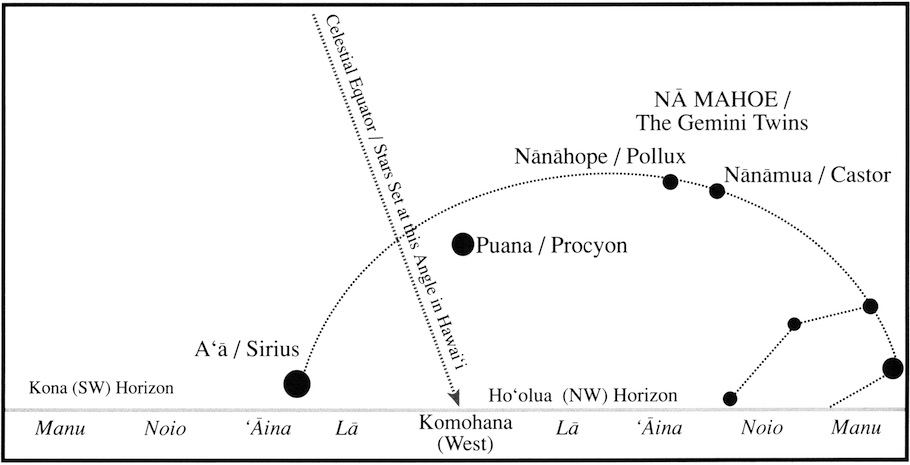
2a. Iwikuamo‘o Rising
With the observer looking E, about nine hours after the sky configuration depicted in the night sky chart 1a, the next starline, Iwikuamo‘o, has risen. The stationary Hokupa‘a (North Star), marked by the small white cross (+) remains stationary above north. Na Hiku (Big Dipper) has risen far above Hokupa‘a, the two front star now pointing down toward it.
To the right of Na Hiku, with the handle of the dipper pointed down toward it, is Hokule‘a (Arcturus), having risen at ENE, now 55 degrees above E, having angled to the right.) To the right of Hokule‘a is the star Hikianalia (Spica), which rose from E by S. [Hikianalia is actually lower in the sky (at an altitude of 49 degrees) than Hokule‘a, but appears higher because of spatial distortion toward the side and top of the chart.]
To the right of and with its top stars at about the same altitude as Hikianalia is a small square composed of four relatively dim stars, with the top narrower than the base: Me‘e (Corvus). [Me‘e appears higher than Hikianalia anhd tilted back when in reality it is lower and upright because of distortion at the side and top of the chart.]
Below Corvus, just above the horizon between SE and S are the bright stars Na Kuhikuhi, or the Pointers, Kamailemua (Beta Centauri) and the brighter of the two, Kamailehope (Alpha Centauri), having just risen at SSE. They point up toward the rising Hanaiakamalama (Southern Cross) which will pass in low arc above S. (It is rotating around the SCP, marked by the small white cross below the horizon, directly below S [but which appears in the chart to the left of S due to distortion in the two-dimensional chart].)
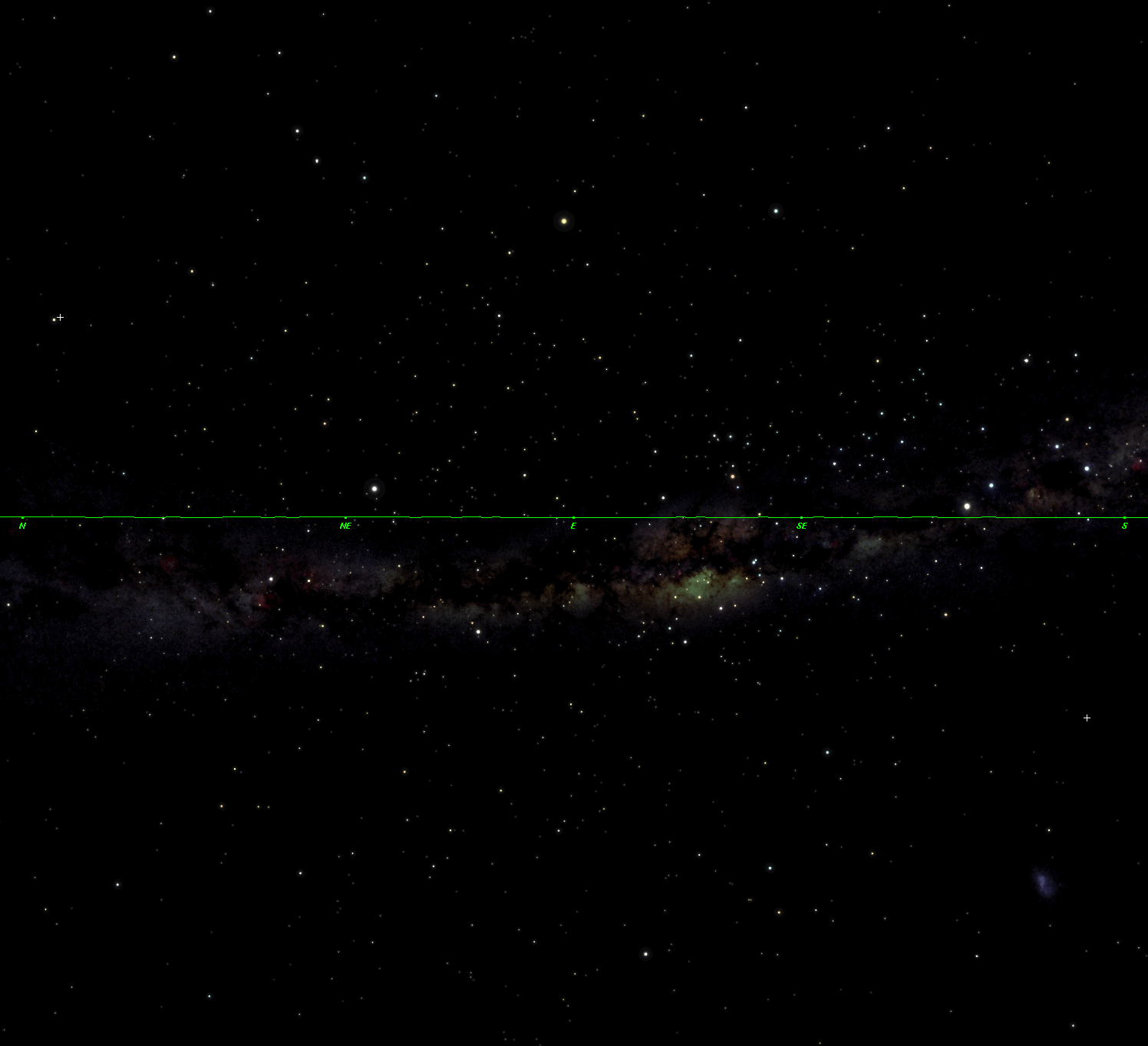
The stars of Iwikuamo‘o, also called the North-South Star Line
Just below the horizon, parallel to it and extending from N to S, is I‘a, Fish, as the Milky Way is known in Hawai‘i. At SE, below the horizon, in the mouth of the fish (its head and jaws formed by the luminous star-cloud of the Milky Way galaxy), is the upright Ka Makau Nui o Maui (the Great Fish Hook of Maui) embedded in the jaw of the celestial fish, the hook below the horizon, the shank above it. Ka Makau Nui o Maui is the first constellation to rise in the third star line, Manaiakalani, “Chief’s Fishline” or “Come from Heaven,” the name of Maui’s hook.
The star line of Iwikuamo‘o:
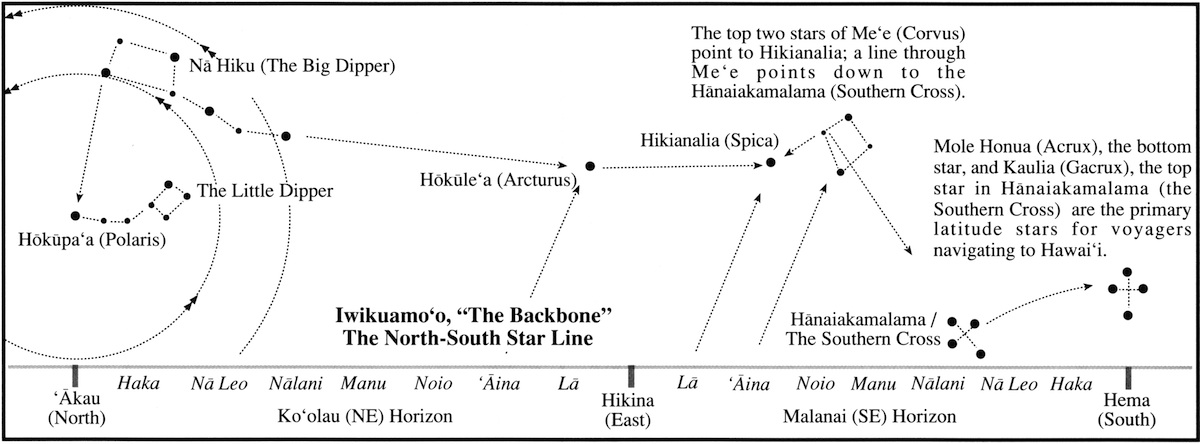
2b. Iwikuamo‘o Setting
With the observer looking W about 4 hours after the night sky configuration depicted in chart 2a-Iwikuamo‘o Rising, the southern stars of Iwikuamo‘o are setting toward the horizon. Hanaiakamalama, the Southern Cross has dipped into the horizon, two stars above it and two stars below it, at SSW. Na Hiku (Big Dipper) is now to the west (left) of Hokule‘a (Arcturus), the front edge of its cup still pointing at Hokupa‘a (North Star) and its handle pointing at Hokule‘a, the bright star high above W. An hour and a half earlier, as it crossed the meridian, passing very near the Zenith, the point in the celestial sphere directly overhead. Hokule‘a is known as Hawai‘i’s Zenith Star.
About midway between Hokule‘a and Hanaiakamalama, the Cross, is Hikianalia (Spica) and directly below it is in the box of Me‘e (Corvus).

Below the horizon, having completely set, is the star line of Ke Ka o Makali‘i.
3a. Manaiakalani Rising
In the night sky chart below, with the observer looking E two hours after the sky configuration depicted in chart 2a – Iwikuamo‘o Rising, the first constellation to appear in the third star line has risen: Ka Makau Nui o Maui (the Great Fish Hook of Maui) is above the horizon and has pulled the I‘a (Fish, or Milky Way) out of the ocean. Also rising in the Manaiakalani starline is the Navigator’s Triangle, three relatively bright stars between NE and E: Keoe (Vega), Pira'etea (Deneb), and Humu (Altair).
The brightest of the three stars in the triangle, Keoe (Vega), appears between the other two and higher up, having risen earlier at NE, then rising at an angle of 21 degrees toward S.
Below Keoa and just north of east, between the horizon and a star-cloud of the Milky Way, Humu has just risen at the border of E and E by N. Pira'etea (Deneb) is the bright star just above NE, from where it rose.

Below the horizon, is the next starline, the fourth and last, Ka Lupe o Kawelo (The Kite of Kawelo) , dominated by Ka Lupe (the Great Square of Pegasus) will be the next to rise. This square appears below NE, tilted a littler to the right. Below the horizon to the right of north, is the other major constellation of this starline, ‘Iwakeli‘i (Cassiopeia), in its configuration of a wide W (when it is below the NCP). Another bright star in this fourth line is Achernar, toward the bottom right of the chart, down and to the right of SE. This star will rise in Hawai‘i at SSE, eight hours later.
This graphics shows the angle of rising:
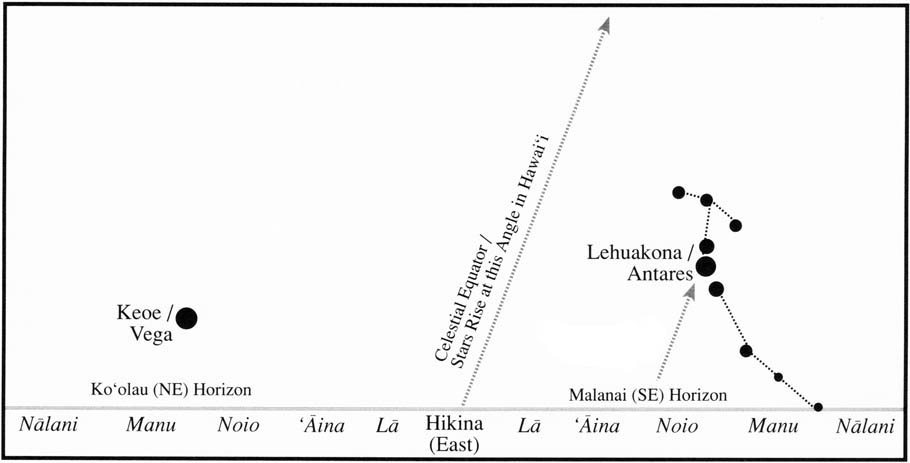
3b. Manaiakalani Setting
With the observer looking W about four and a half hours after the sky configuration depicted in chart 2b, Ka Makau (the Fishhook, Scorpio in the West) in Manaiakalani approaches the horizon, now on its side, with its point above, and Ka I‘a, the celestial fish swing up past perpendicular to over W and NW. (Huli ia i‘a, “the Fish has turned.”) Hokule‘a is setting at WNW. The Navigator‘s Triangle is still high in the sky above W-NW. Keoe (Vega) the brightest of the three will set first, in about five hours, at NW, Humu (Altair) follows, setting 14 minutes later at W by N, and two hours and 10 minutes later, Piraete‘a, at NW.
Na Hiku has partially set, its cup in the ocean below NNW and its handle still pointing at the setting Hokule‘a.

This graphic depicts of angle of Manaiakalani setting in Hawai‘i.
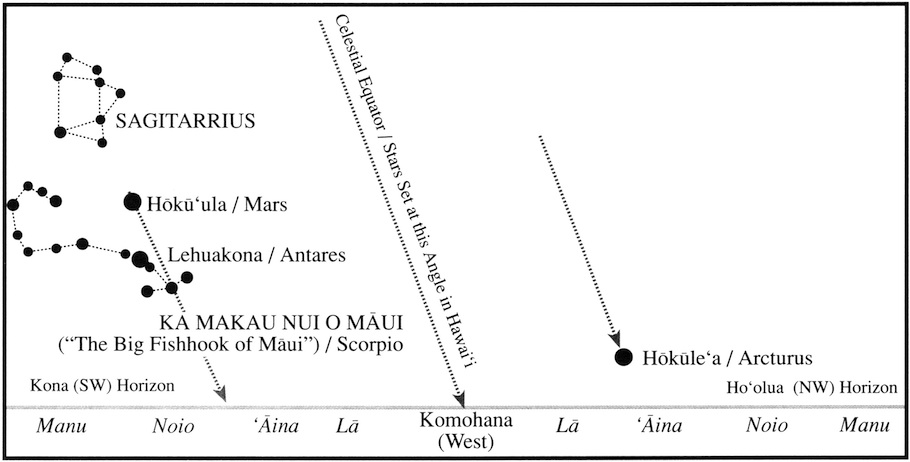
4a. Ka Lupe o Kawelo Rising
With the observer looking E six hours after the sky configuration depicted in chart 3a, Ka Lupe (the Great Square of Pegasus) is in the sky, tilted a little to the right, above the horizon just north of east. It rose in the section of the sky around ENE.
‘Iwakeli‘i (Cassiopeia) in the shape of a wide W, now tilting to the right appears above NE as it circles to the east (right) of Hokupa‘a (North Star). It rose at NNE. Between NE and E are two stars in Aries, Hamal, lower, on the left, and Sharatan, rising from ENE. The bright star Achernar, below SE, is rising toward SSE.

Below the horizon is Ke Ka o Makali‘i, the Bailer of Makali‘i. (See chart 1a for a description of this star line.)
Ka Lupe o Kawelo rising from ENE:

4b. Ka Lupe o Kawelo Setting
With the observer looking W seven hours after the sky configuration depicted in chart 3b, Ka Lupe, the Great Square is approaching the horizon between W and NW. At NW, the last star in the Navigator’s Triangle, Piraete‘a (Deneb) is setting. Above Piraete‘a ‘Iwakeli‘i has rotated to the west (right) of Hokupa‘a.
On the left side of the chart, Acherner, is above the horizon between S and SW, will set in 15 minutes at SSW. Between SW and W the star Fomalhaut is setting, at SW by W.
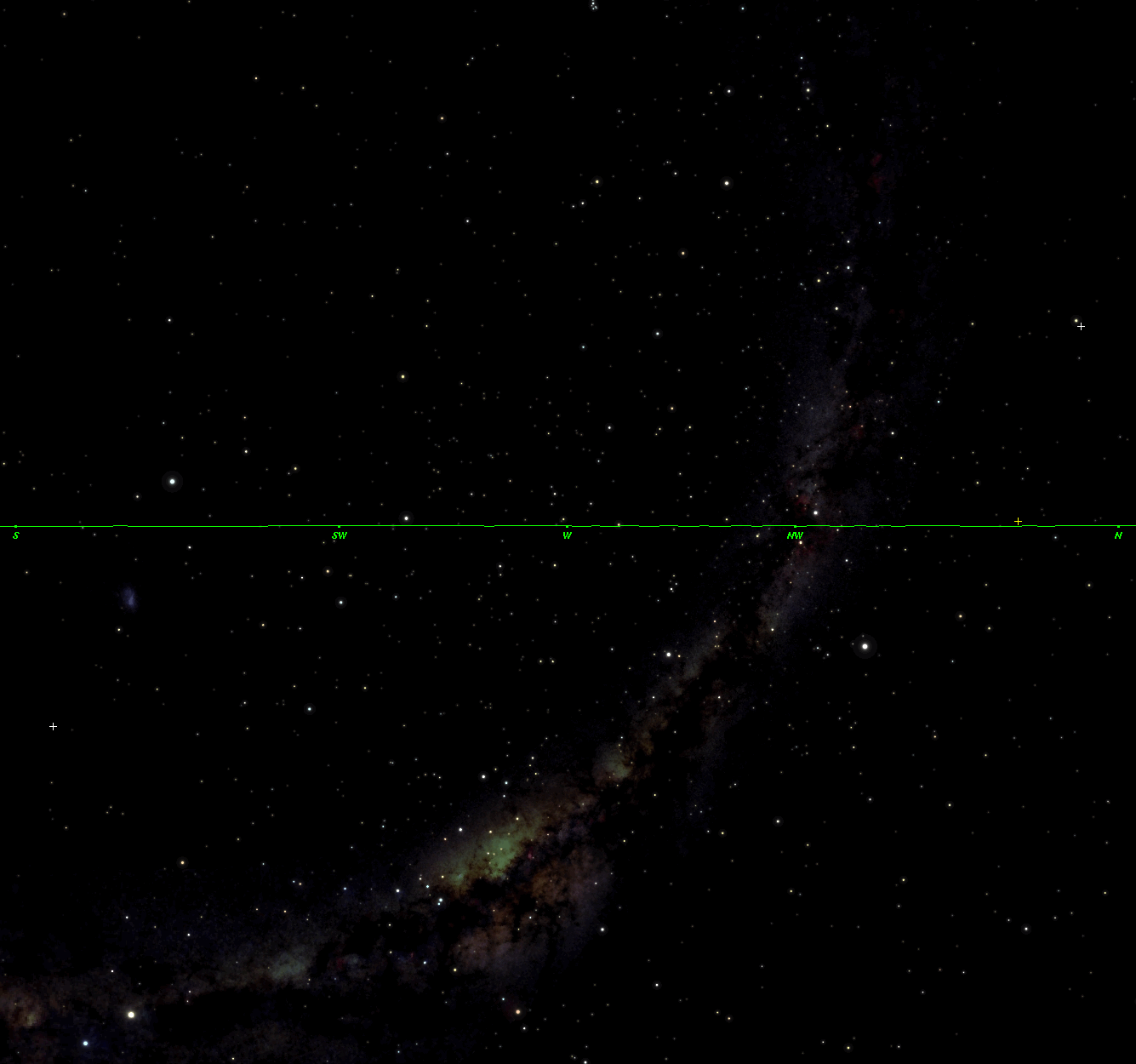
Below the horizon is the starline Manaiakalani, Ka Makau, the fishhook, upside down, still dragging the celestial fish.
Ka Lupe o Kawelo setting:
